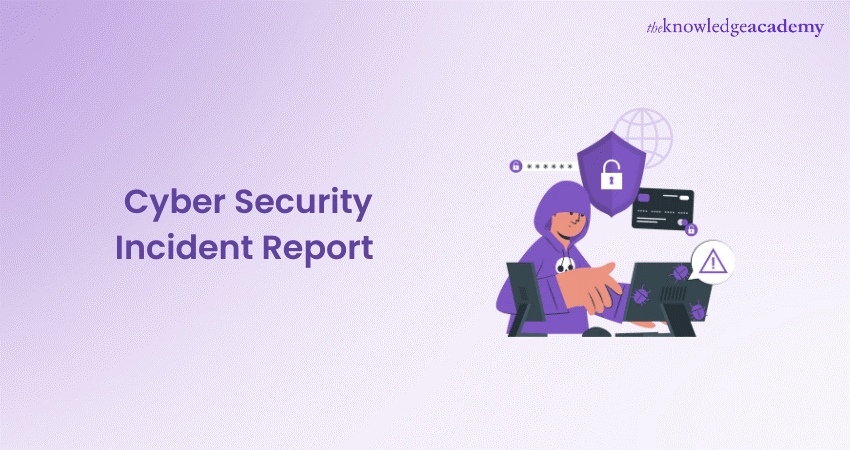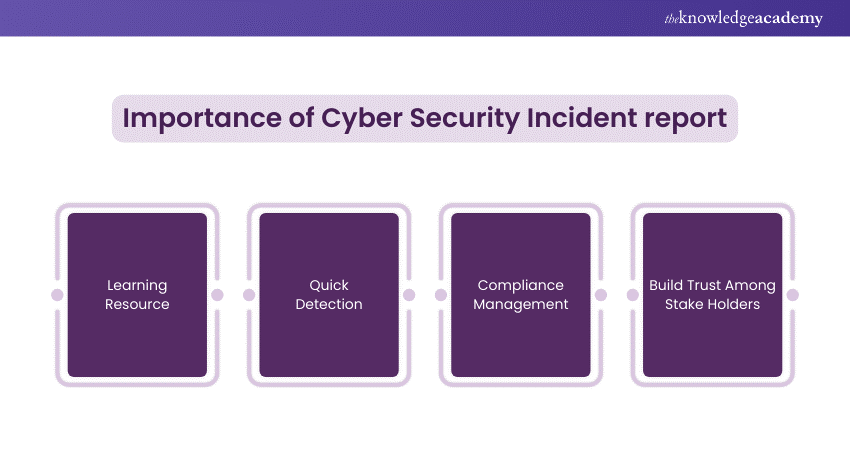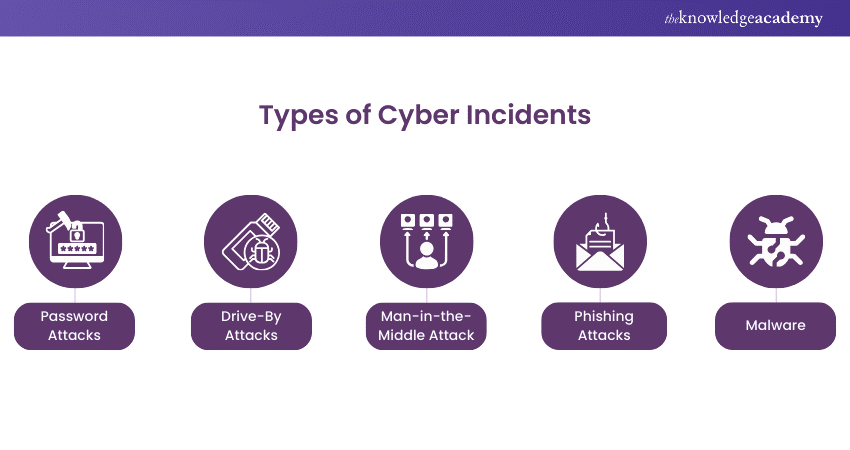We may not have the course you’re looking for. If you enquire or give us a call on 01344 203999 and speak to our training experts, we may still be able to help with your training requirements.
Training Outcomes Within Your Budget!
We ensure quality, budget-alignment, and timely delivery by our expert instructors.

Countries like Russia, North Korea and China are constantly testing and trying to penetrate their rival's Cyber Space. Although around the world there were 2,365 Cyber-attacks in 2023 with 343,338,964 victims and 72% increase in data breaches since 2021 which is a record breaker number from previous years.
Cyber Security Incident Reporting is the term which consists of the details of an attack that has happened. The report has the time of the Incident, systems that are affected, the type of attack that happened to inform the stakeholder and management of the company to start the remediation process and initiate triage.
Table of Contents
1) What is a Cyber Security Incident Report?
2) The Importance of Cyber Security Incident Report
3) Various Types of Cyber Incidents
4) Steps to Create a Cyber Security Incident Report
5) Why is it Important to Report a Suspected Cyber Security Incident Right Away?
6) Conclusion
What is a Cyber Security Incident Report?
A Cyber Security Incident Report is a detailed document for the Cyber-attack and the steps that are needed to be performed by the IT and Cyber professionals to alleviate it. With the help of Incident Report Cyber professionals can immediately and efficiently confine the affected systems and networks and can perform recovery mode to recover the lost data.
The Incident Report can prevent occurring of this kind of attacks in the future because it takes almost 207 days or more than six months to detect the breach in the organisation’s system and it also reduce the damage that has occurred from the attack by giving the quick steps.
The Importance of Cyber Security Incident Reporting
Cyber Security Incident Report provides the exact data and the details of the attack which is needed by the IT and Cyber Security professionals to deal with the Incident and empowers the organisation to make better security policies to get prepared for the future. Here's why Cyber Security Incident Reports are essential:

A Crucial Learning Resource
The information that is collected during Cyber Security Incident can be used to prevent more dangerous Cyber-attacks in the future. With the learning resources the IT and Security teams will get help in improving and strengthening the Security standards that will result in reducing chances of more serious attacks.
Enables Quick Detection and Response
The main and first reason for this report on Cyber Security is its role in helping the organisation’s awareness of Cyber threats and attacks and helping them to increase their Security standards accordingly. The Cyber Security Incident Report includes all the details of the attack which will be very helpful for the company to response and to aware them for their future protection.
Enhances Compliance Management
The primary purpose of Cyber Security Incident Report is to alleviate and manage the impact of Incidents on the company and enhance the Security measures and ensure compliance with regulatory and legal requirements.
Build Trust Among Stake Holders
By starting the process of Cyber Security Incident Report that will show investors and stakeholders that your company is serious about the protection of the data, network and the digital assets. This will help in gaining the trust of potential investors and clients of the company.
What are you waiting for to get in-dept insight into Cyber Security and Its importance. Sign up for our Cyber Security Awareness Course now!
Various Types of Cyber Incidents
The various types of Cyber Incidents that typically an Incident Report covers are:

Password Attacks
Red Hat Hackers or Cyber criminals can manipulate the accounts to steal passwords to access the user's account without knowing and unlawfully. These hackers or the criminals use tricks and certain software's such as password cracking software, brute force attack, sniffing and the password guessing technique to gain the access of the user.
Drive-By Attacks
This is the type of attack in which the victim is redirected to another malicious website when they click on the link that is inserted or scripted in the trusted website. These links often have pop ups like “Winning a lottery” and “Dating Tips” etc.
Man-in-the-Middle Attacks
The Man-in-the-Middle (MITM) Attacks defines the involvement of intruder that accesses the private communication on a network and the Cyber criminal's setup this attack by gaining access to a network that is used for private communication, and this (MIMT) is the type of attack which is Imperceptible.
Phishing Attacks
This type of attack is done using false websites and emails to collect the information of the person or any organisation illegally and Phishing Attack majorly targets confidential and private information such as passwords and bank details.
Malware
Malware is software that penetrates machines through unauthorised installations and causes harm to them. It includes script injectors, worms, trojans and ransomware. Users may also be tricked to unknowingly install malware or malicious scripts when installing legal software's such as antiviruses and freeware.
Get registered with us for Cyber Security Awareness Courses to learn more about the significance of Cyber Security.
Steps to Create a Cyber Security Incident Report
Basically, while creating a Cyber Security Incident Report the straightforward procedure is to add five major Cyber Security Incidents in the report and typically the agencies and companies uses NIST or SANS frameworks.
NIST Framework
NIST Framework is the most popular framework that Cyber Security and IT professionals use to draft a Cyber Security Incident Report. It is a flexible set of instructions and is designed to help the organisations manage and reduce the risks of Cyber-attacks. This majorly outlines four steps:
1) Preparation
2) Detection and Analysis
3) Containment, Eradication, and Recovery
4) Post-incident activity
SANS Framework
The SANS Framework is an important extension of NIST. It is the world's largest and most reputable Cyber Security research organisation. The SANS approach facilitates analysts to carefully assess Cyber-attack damage, act and help the organisation in recovery. This mainly outline the six steps of writing a Cyber Security Incident Report:
1) Preparation
2) Identification
3) Containment
4) Eradication
5) Recovery
6) Lessons Learned
Preparation Phase
A Cyber Security Incident Response Plan (CSIRP) should be established well in advance of any potential breaches. Proper planning prior to an incident enables organisations to respond to security events efficiently and swiftly.
The response plan must be comprehensive, outlining the roles and responsibilities of each team member along with their contact information, ensuring that all participants are aware of their specific duties in the event of an incident. Each member of the team needs to understand their place in the team and what they need to do when a breach occurs.
Incident prevention in the second step of the Preparation Phase which involves activities such as malware prevention, risk assessments and host security checks.
Detection and Analysis
The Analysis and Detection phase in a Cyber Security Incident Response Plan (CSIRP) is initiated as soon as an incident occurs, and the organisation needs to respond to the threat. This phase typically outlines the steps for analysing and verifying the incident, providing guidance on identifying and assessing the nature of the cyber-attack.
It is not feasible to create a specific response plan for every type of security incident due to the variety of potential attack sources. To address this challenge, the NIST framework offers a set of common attack scenarios and prevention methods, which serve as a foundational guide for handling security events effectively.
Containment, Eradication, and Recovery
This is the main part of the Cyber Security Incident Report because everything that will be done in the counter of the attack will rotate around the Incident, eradicating the threat and recovering from the attack. NIST has provided the list of several criteria that can be used when determining containment strategy:
1) The theft of resources or degree of damage
2) Preserving the evidence
3) Resources and time needed to make good strategy
4) Service Availability
5) Duration of solution
Effectiveness of the strategy
When working in this phase, collect as much evidence as you can about the attack and preserve it for external and internal use. It will be time consuming or even impossible in some cases, but the authorities can also work on identifying the attacking host.
Post-Incident Review
After the Incident has been stopped and the security measures have been implemented, this step involves debriefs to inform the IT, Cyber Security team and the organisation. It includes what caused the Incident, what happened and how it can be prevented in the future. The key points will be:
1) Light on what has happened
2) Assess the damage and severity
3) Revisit the Cyber Security Incident Report
4) Begin the notification process
Cyber Security Incident Report Checklist
Before wrapping up, note down the seven step checklist for an Incident Report in Cyber Security:
1) Conduct an Enterprise-Wide Risk Assessment to identify the acerbity of Cyber-attacks in the major area and make sure the risk assessment is current and updated.
2) Identify Key Team Members those need to be contacted during the Incident and Stakeholders need to be informed about what has happened during the time to ensure them.
3) Security Incident Types that need to be there to define what counts as an Incident and who will be the InCharge of plan activation.
4) Inventory Resources and Assets that needs to be already there for the security protection and implementation of all the plans at the time of Incident.
5) Outlining the Sequence of Information Flow for a closer look at your assets and what are the that need to be taken to kick off different processes?
6) Preparing a Variety of Public Statements with appropriate data breach notification ready in advance to reduce the reputational damage that is caused by the Security Incident.
7) Preparing an Incident Event Log to keep an eye on all the steps that need to be taken during and after a Cyber Security Incident so to keep the efficiency of your response and obtain a lesson.
These are the seven main checklist steps that need to be kept in mind for a Cyber Security Incident Response Plan or for the Incident Report.
Conclusion
Cyber Security Incident Reports are not just a reactive measure but a proactive strategy to strengthen digital defenses. They help organisations document breaches, analyse vulnerabilities, and create a knowledge base for preventing future incidents. Given the rapid rise in cyber-crimes maintaining a robust incident Reporting process is no longer optional; it’s a necessity.
Check out our courses on Cyber Security Incident Reporting Training to gain expertise in this field.
Frequently Asked Questions

There is a Three-Step Procedure for Cyber Security Incident Response That is Record in Which the Report Begins With Accurate Recording of Event Details and Second one is Remediate in Which Security Team Analyse the Incident and in the Last Step is to Report the Incident According to the Plan and Strategy.

It Typically Outlines What Occurred, Defines What Steps Need to be Taken to Prevent Future Events and Provides the Analysis of the Incident. At Minimum it Should Include the Answers of who, where, what and why of the Incident That has Happened.

The Knowledge Academy takes global learning to new heights, offering over 30,000 online courses across 490+ locations in 220 countries. This expansive reach ensures accessibility and convenience for learners worldwide.
Alongside our diverse Online Course Catalogue, encompassing 19 major categories, we go the extra mile by providing a plethora of free educational Online Resources like News updates, Blogs, videos, webinars, and interview questions. Tailoring learning experiences further, professionals can maximise value with customisable Course Bundles of TKA.

The Knowledge Academy’s Knowledge Pass, a prepaid voucher, adds another layer of flexibility, allowing course bookings over a 12-month period. Join us on a journey where education knows no bounds.

The Knowledge Academy offers various Cyber Security Trainings, including the Cyber Security Incident Report Training and Incident Response Training, and the Cyber Security Awareness Course. These courses cater to different skill levels, providing comprehensive insights into Cyber Security Risk Management.
Our Cyber Security Blogs cover a range of topics related to Cyber Security, offering valuable resources, best practices, and industry insights. Whether you are a beginner or looking to advance your Security Risk Management skills, The Knowledge Academy's diverse courses and informative blogs have got you covered.
Upcoming IT Security & Data Protection Resources Batches & Dates
Date
 Incident Response Training
Incident Response Training
Fri 15th Nov 2024
Fri 3rd Jan 2025
Fri 28th Mar 2025
Fri 23rd May 2025
Fri 4th Jul 2025
Fri 5th Sep 2025
Fri 24th Oct 2025







 Top Rated Course
Top Rated Course



 If you wish to make any changes to your course, please
If you wish to make any changes to your course, please


